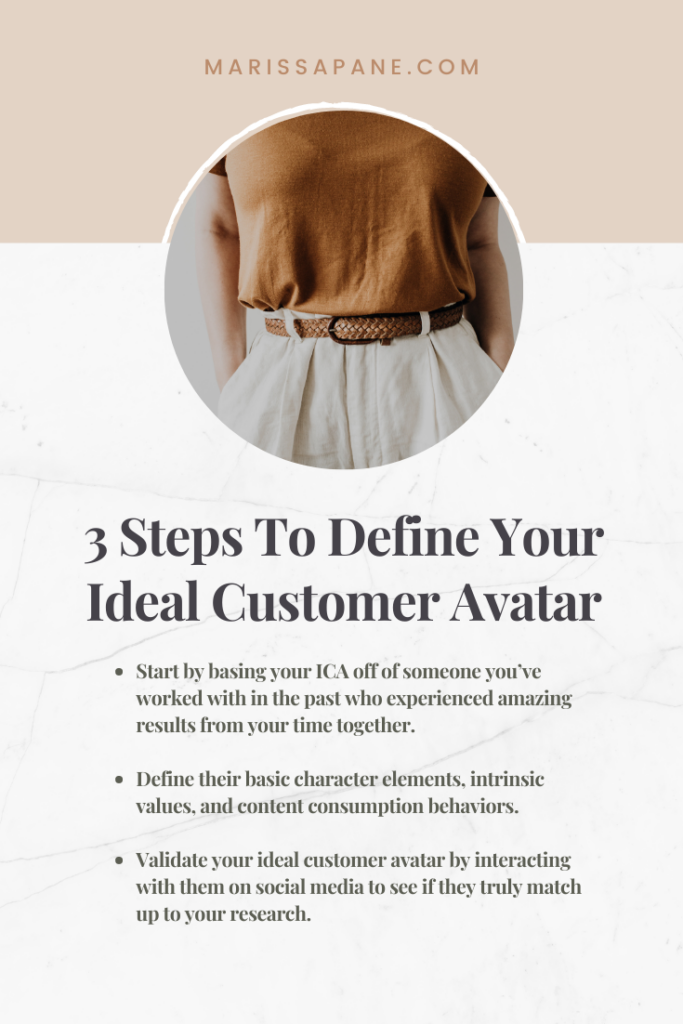Feel like your content is hitting a wall? No matter what you post, it just isn’t connecting with your audience? You’re going to continue to struggle to create content that truly resonates with your people until you know exactly who you’re talking to. That’s where defining your Ideal Customer Avatar (ICA) comes in.
Defining your ICA isn’t just a fluffy marketing exercise where you’re slapping a name and demographic on a persona; it’s a foundational step that shapes everything else in your business. It’s how you’ll create content that resonates, messaging that converts, and a brand that stands out.
If you don’t know who your ideal client is, how can you expect to create content that speaks to them?
You can’t. And that’s why so many brands end up with content that’s just… meh.
I hate to break it to you, but building your ideal customer persona is so much more than knowing their name, age, sex, and location. (You’re not in AOL chat rooms anymore.) You have to dig deeper and understand the very soul of who you’re serving.
The First Step To Determine Your Ideal Customer Avatar
When first strategizing who your ICA should be, I recommend trying to base it on someone you’ve worked with in the past who experienced amazing results from your time together or someone you genuinely enjoyed working with. What was it about that specific person that helped them to achieve the best results possible? Was it their learning style? Was it the way that you connected?
By understanding what worked with this client relationship, you can then model your ideal customer avatar after that person.
Exercise to try:
- List your top 3 most successful client relationships
- What made each client relationship successful?
- What characteristics did they have that contributed to their success?
- How did your product/service specifically meet their needs?
Another way to go about defining your ideal customer is to base it off of a past version of yourself. (This is what I did in my first business!) If you were in a place of need a few years or even a few months ago and you learned a skill to assist that need, basically filling the gap to become the solution to the problem, you can now teach other people how you achieved this. If the person you’re trying to target with your business is a past version of yourself, you can use this as your starting point.
Exercise to try:
- Describe your situation before you developed your current skills/product
- What were your pain points?
- What solutions were you seeking?
- How did you overcome your challenges?
The Details To Consider When Defining Your Ideal Customer Avatar
Both of the aforementioned scenarios are great places to start, but this idea of your ideal customer shouldn’t just be a thought in your head. You don’t want to stop here. You have to dive a lot deeper into defining your customer avatar to make sure the content you’re producing is truly going to help the specific person you’re trying to reach.
A few basic elements to consider are their name, age, geographic location, marital status, current employment, annual income, family situation, etc.
Basic Demographics
- Name
- Age
- Geographic location
- Marital status
- Current employment
- Annual income
- Family situation
Those basic elements are necessary to define, but their intrinsic values are what will really bring your ICA to life.
Think about their goals. What do they value? How do they take in and digest information? Are they a visual learner? Are they a reader? Are they a video watcher? Are they a podcast listener?
What are their challenges? What is the main challenge or pain point that your product or service is helping them solve? What do they want most of all in their life, that you can help them achieve?
Intrinsic Values:
- Goals and aspirations
- Core values
- Learning preferences (visual, auditory, kinesthetic)
- Challenges and pain points
- Desires and motivations
What are the possible objections they could have that would prevent them from investing in your products or services? Is it a mindset objection? A financial objection? Or something else entirely?
People will always have objections, whether it’s a mental block or it’s the hard facts of life. That being said, it’s always a good idea to look into the future and estimate what their objections might be.
Potential Objections
- Mindset blocks
- Financial concerns
- Time constraints
- Trust issues

The Clarity Moment Questions That Help Define Your Ideal Customer Avatar
Once you’ve covered the basic elements and their intrinsic values, you’re going to dive into what I consider the clarity moment questions. With many years in the marketing world under my belt, I have been through countless ICA exercises. It always seemed like some fluffy nonsensical idea until I was presented with the following questions. That’s when it all clicked for me. These are the questions that made me go, “Huh, I get it now. It’s not just a stick figure that I’m drawing up, it’s an actual person!”
The Clarity Moment Questions:
- Who are they following on Instagram?
- What types of books do they read?
- What magazines do they always pick up?
- What was their last Youtube search?
- What do they search for on Pinterest?
- What bookmarks do they have saved on their web browser?
When you look at questions like these, you’re able to better understand the content they devour which helps you gain a better sense of their driving factors.
For example, if you see that someone is frequently visiting Pinterest and Instagram versus platforms like Threads and Reddit, you’re able to come to the conclusion that this person is much more of a visual learner or enjoys consuming visuals over text-based content.
Why Your Small Business Needs To Define Its Ideal Customer Avatar
If you’re wondering why any of this matters, it’s because now you have a bigger picture of who your ideal customer avatar is, what they want, and what they need.
The more specific you get when defining your ideal customer, the easier it will be to make your content seem truly authentic. The end goal is to make your ICA feel like you can read their mind and that the content you created was made specifically for them.
When you write a post, you want someone to be like, “Oh my goodness, how did you know that was exactly what I was feeling?” That mind-reading effect will land you more sales and inquiries on how to work together.
Validating Your Small Business’s Ideal Customer Avatar
The final step of the process is to validate your research.
You can think and brainstorm about your ICA all day and night, but this information is just a fun storyline until it’s validated.
Find your ideal customer avatar in the wild. AKA go on social media and confirm that what you think this person wants is truly what they want.
You can start by finding people on Instagram and popping into their DMs to ask them questions. Interact with their posts, start conversations in Facebook groups, or even offer free consult calls or schedule virtual coffee dates.
Once you dedicate 15 to 30 minutes with five or six people, you’ll have a solid understanding of whether or not your research was accurate or if you need to go back to the drawing board.
A few questions to ask your potential ideal customers:
- If you could wave a magic wand and get the result you’re searching for, what would happen?
- What has been standing in your way from achieving ______?
- Where do you typically spend your time online?
- What’s your go-to source for information and answers when you have questions?
Creating Content For Your Small Business’s Ideal Customer
Once your research is complete and validated, you’ll be able to continuously create scroll-stopping content that your audience won’t be able to get enough of.
Not too sure where to start when it comes to creating content? I’ve got you covered in this free Content Marketing Blueprint. When you download this free resource, you’ll discover topics like:
- Understanding your customer’s buying journey and the content you need to create to align with their needs based on the stage they’re in.
- How to map out your business objectives and brand messaging so every piece of content you create relates back to your overall business goals.
- Why you should be using data and conversations with your audience as research opportunities for future content creation.
- How to plan and organize your content ideas across multiple channels in one centralized location to make your life easier.
- Tips for repurposing and remixing your current long-form content pieces into social posts.
Looking for even more actionable content marketing insights?
Subscribe to the Content Pour-Over to sip on marketing insights every Wednesday morning that will enhance your content through buyer psychology and brand strategy principles.
